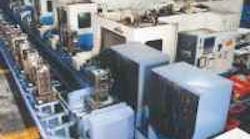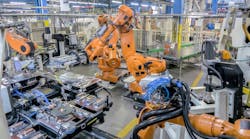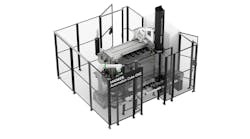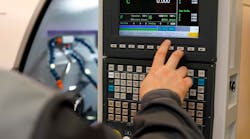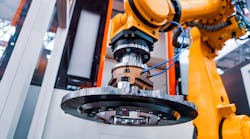Profitability and growth for part manufacturers requires market driven flexibility.
To produce the thousands of standard parts in small lots, ISI/Norgren installed a Mazak Palletech eight-pallet manufacturing cell with an Ultra 550 horizontal machining center. It has now grown to four machines and 40 pallet stations.
Using tombstone fixturing on a combination of parts, a Mazak Ultra 550 taps a hole in one of ISI/Norgren's 11,000 standard parts.
Keeping the Palletech Ultra 550 machines running 24-hr / day requires dedicated fixturing involving one part or the use of tombstone fixtures with multiple parts on each side.
Manufacturers today need flexibility to produce many different parts while keeping their inventories to an absolute minimum. Produce too many of one part and money is lost through idle inventory. Build too few parts and profits are lost along with a potential loss of customers. In order to walk this tightrope, manufacturers are turning to flexible machining systems for high-volume production in small lot quantities.
One manufacturer finding a way to successfully walk the tightrope is the Handling Division of ISI Norgren Inc., Mt. Clemens, Mich. The plant produces 3.4 million variations of its 11,000 standard products per year for automation and material-handling equipment. It turns out products like vacuum cups, modular conveyer systems, grippers, clamps, end effectors, and other devices that hold parts as they are being moved and positioned by robots or other handling devices.
John Walton, vice president of manufacturing points out that such volumes of that broad product range could easily result in exorbitant levels and costs of inventory. "If we are to manufacture and ship at competitive costs, then we need efficient processes. To prevent inventory accumulation, we must have flexibility at every possible point."
"For many of our operations CNC is the perfect answer," he adds. "We have 66 CNC machines in the plant. Some are stand-alone, mostly with one operator running several machines. Others, such as the pallet-changing machining cells, have at least two pallet stations each per machine. Spindle downtime time is reduced by machining parts on one pallet while the other is being set up. Most machining centers have a multiple-pallet line, so they are capable of running unattended, and most of those are dealing with families of parts."
Pallet cells the ultimate answer for flexibility
Although its CNC machines were doing a good job, ISI Norgren required even greater flexibility to pump out thousands of standard parts in small lots. After investigating many systems, the company bought a Mazak Palletech eight-pallet manufacturing cell with an Ultra 550 horizontal machining center.
"The Palletech is targeted for the shorter runs because of its extraordinary flexibility," says Paul Morse, manager of machining and processing. He adds, "because of the flexibility, we have also exchanged an 80-tool storage magazine for one with 120-tool capacity. And, after learning about using the cell for unattended operations, we have added three additional Mazak Ultra 550 machining centers and a total of 40 pallet stations to the cell."
Dedicated tombstone fixturing for parts and the easy movement of pallets within the system keep the four Ultra 550 machines running 24 hr / day. Operating the entire cell requires two 10-hr shifts with two people on each shift, leaving four hours of unattended production.
The Mazak machining centers have 7,000-rpm spindles with 25-hp output and feature a rapid traverse and X and Y axes cutting feedrates of 1,000 ipm. About 25% of the 120 tools in the storage magazine are identical on all four machines, allowing ISI to machine a large number of standard parts on any of the machines. Tool change cycle time is 6.5 sec from chip to chip.
According to the company, the major attribute of the Palletech is the near elimination of spindle downtime during part setup resulting in shorter production lead times. "Product must ship within three weeks from receipt of the order and with 11,000 different components in the line, meeting our deadline is difficult, but it is also a competitive factor in the markets we serve," comments Walton. "About 90% of our customers are end users, including a large share of the automotive industry. They cannot afford downtime and we do not intend to be the ones making them wait," he concludes.
At ISI Norgren, Mazak's Palletech manufacturing cell uses a Windows-based advanced flexible manufacturing system (FMS) controller to move pallets with a rail-guided transporter. In the cell, pallets are automatically transferred from the loading station to the pallet stocker as needed and not sequentially. From there, the pallet is moved to one of the machining centers in the system by the transporter.
ISI Norgren's system features an optional Mazak pallet management system that uses read/write chips mounted on the pallets. The machines read the information in these chips and make adjustments prior to cutting. After machining, information being reported to the load-ing-station operator is written on the chip. At the loading station, it is then read and other data is written.
Because the pallet actually carries the information pertaining to it, the management system is capable of workpiece coordinate-system compensation according to pallet/machine combinations and storage and display of the workpiece measurement results.
The Palletech controller commands the sequence to transport the pallets according to the programmed production schedule. In order to prevent a machining center from being idle because it is waiting to be unloaded, the pallet loader has a fast traverse speed of 197 ft/min and a fork transfer speed of 1,180 ipm.
